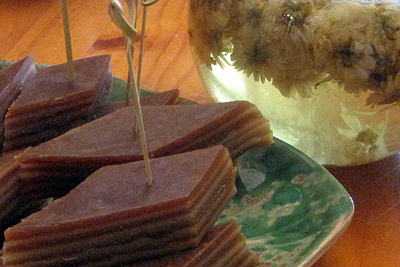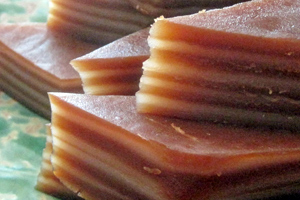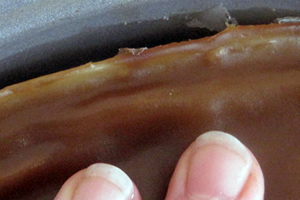
By Carolyn Phillips
China has three great holidays -- the Lunar New Year in early spring, the Dragon Boat Festival in midsummer and the Moon Festival in autumn -- but the rest of the Chinese year is sparked with other days of remembrance, thanksgiving and celebration. Double Ninth Festival (on Oct. 23 this year) is a traditional favorite not only because it honors the elderly, but also because of its delicious combination of sweet cakes and chrysanthemum tea.
Tradition holds that Double Ninth is the perfect day to climb high hills, admire the chrysanthemums that are in full bloom and sip tea or wine made from those flowers; in the best of all worlds, these three are done at the same time. Signs of great changes in the seasons can be seen in the world around us; one old Chinese saying tells us that this is when wild geese gather and fly south, sparrows dive into the sea and turn into clams, and chrysanthemums bear yellow flowers.
Rice wine scented with chrysanthemums is rarely seen anymore - for no good reason that I can determine - but the blossoms can be turned into the most impeccable tea. Look for flowers that are grown in Hangzhou in Jiangsu province. Their fragrance is legendary, and they produce a tisane that is almost honey-like; it's sweet and luxurious on the tongue, the essence of autumn.
Double Ninth Festival has unique cakes for each region

This is a charming confection of layers flavored with brown and white sugars, with a touch of banana extract to give it that quintessential Taiwanese flavor. It looks terribly difficult and sophisticated, but the truth is, this is a snap to make. All you have to do is mix up two thin batters of little more than rice flour, water and sugar, and then these are steamed in layers ... nine to be exact, which makes this a perfect snack for Double Ninth.
One thing to note is that instead of sticky (or glutinous) rice flour, as is used in mochi, the recipe calls for non-sticky rice flour, which provides a softer, more delicate texture that practically melts on the tongue.
Versions similar to this can be found throughout coastal southern China, as well as in Southeast Asia. On the Chinese island of Hainan, for example, fragrant pandan leaves are used instead of the brown sugar, and this confection ends up with alternating layers of white and a brilliant emerald green.
Follow Chinese tradition and offer your friends some slices of cake, sip some chrysanthemum tea together, warm your toes in the fleeting autumn sun and welcome the coming days of cold weather and hot foods.
Hakka-style Nine Layer Cake - 客家九層糕 Kejia jiucenggao
Serves 8, generously
Ingredients
2½ cups Indica rice flour (see Tips)
2½ cups cool filtered water
6 tablespoons white sugar
¼ teaspoon banana extract (optional)
½ cup dark brown sugar (Korean black sugar is excellent)
Directions
1. Mix the rice flour and water together in a large measuring cup until you have a smooth slurry.
2. Pour 1½ cups of the slurry into a 32-ounce measuring cup, and stir in the white sugar and optional banana extract.
3. Stir the brown sugar into the remaining slurry until the sugar is more or less dissolved.
4. Select a square or round cake pan (anything from 8 to 9 inches wide is perfect) that fits easily into your steamer. Line the bottom of the pan with parchment paper and spray the inside of the pan lightly with oil. Place the pan in the steamer and raise the heat under the steamer to high.
5. Starting with the brown sugar slurry, pour ½ cup of the slurry into the cake pan, moving the pan around so that it even coats the bottom of the pan. Be sure that the steamer and pan are level so that you end up with even layers. Cover the steamer and cook that layer for about 2 minutes, or until the surface is solid.
6. Pour 6 tablespoons of the white slurry on top of the brown layer, again moving the pan around so that it coats the bottom evenly. Cover the steamer and cook the cake for another 2 minutes. Repeat these two steps, alternating the brown and white slurries, until you have finished it all up; you should end up with nine even layers.
7. Cover the steamer and steam the cake over medium-high heat for 15 minutes, adding more water as necessary to the steamer. Turn off the heat, remove the cake, and let it cool to room temperature. Then loosen the cake by pulling gently the edges toward the center of the pan, and empty the cake out onto a serving plate. Cut the cake into diamonds, arrange the pieces attractively and serve.
Tips

- Indica (long grain) rice flour can be found in most Chinese grocery stores, where it is also known as zailai mifen 在來米粉.
- The best-tasting banana extracts are the more natural ones found in health food stores.
- Korean black sugar is an extra dark variety with a pronounced caramel flavor; it is generally found only in Korean grocery stores.
- Give each slurry a quick stir before you pour it to ensure that the sugar doesn't sink to the bottom.
- Store the finished cake for a day or two at the most at room temperature. Cover it well.
Photos, from top:
Hakka-style nine layer cake with chrysanthemum tea.
Cut the cake into diamond shapes.
Pull the cake loose from the pan.
Credits: Carolyn Phillips